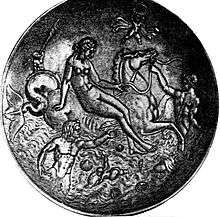Archaeology of Azerbaijan
Archeological sites in Azerbaijan first gained public interest in the mid-19th century and were reported by European travellers.[1]
The Institute of Archaeology and Ethnography of the Azerbaijan National Academy of Sciences now conducts researches into archaeology, ethnography, numismatics, epigraphy, anthropology, ethnosociology and ethnopolitology in Azerbaijan. Since 1999 the Department of History and Archaeology of Khazar University has published the Journal of Azerbaijan Archaeology.
In 1920 the Museum of History of Azerbaijan was established, exhibiting archaeological finds from different parts of Azerbaijan. The Ancient and Medieval History sections of the museum have a total of over 25,000 items. Since 1969, museum archaeologists have been conducting underwater archaeological excavations beneath the Caspian Sea.
Prehistoric findings
Early traces of humans on the territory of Azerbaijan have been found in Azykh Cave (c. 2 million years ago), together with the remains of a fireplace in the same cave dating to 700,000 years BC.[2] The deposits of Azykh Cave span a vast period of the Paleolithic Age from Early Acheulian to Mousterian.[1] The Taglar Cave is considered the richest example of the Mousterian culture in Caucasus and the Near East.[3] The findings in Gobustan and the Damjili Cave represent Early and Late Mesolithic evidence. In the Early Bronze Age the territory of Azerbaijan was the site of Kura–Araxes culture. The artifacts from Late Bronze and Early Iron Ages are represented particularly by over 230 burials in the vicinity of Lankaran.[1]
As a result of surveys and excavations, that began in Mingachevir in 1935, rich archeological evidence from the end of Eneolithic Period to the Late Middle Ages was revealed and more than 20,000 objects have been found.[4] In 2006 a French–Azerbaijani team discovered nine kurgans at the cemetery of Soyuqbulaq. It was dated to the beginning of the 4th millennium BC, which makes it the oldest kurgan cemetery in Transcaucasia.[5] There is also an evidence that the Duzdağı salt deposits in the Araxes valley were already being exploited from the second half of the 5th millennium BC, which is the most ancient exploitation of rock salt attested as of 2010.[6]
The Gobustan National Park, which features prehistoric petroglyphs, is one of the UNESCO World Heritage Sites.
Classical antiquity


The excavations on a cemetery at Yaloylu Tepe revealed important archaeological evidence from the 3rd to 1st centuries BC. The site gave its name to a culture found in the lower parts, steppes and foothills of the Greater Caucasus. In 1926 D. Sharifov discovered previously unknown pottery forms at Yaloylu Tepe.
Notable findings related to Ancient Rome include the rock inscription in Latin at Boyukdash mountain (carved between 81 and 96 AD), which is the easternmost known Roman evidence.[7] It was discovered in 1948 by Ishag Jafarzadeh and mentions Domitian and Legio XII Fulminata. Another Roman inscription, which also mentions that legion, was reportedly seen in 1934 by the paleobotanist Petrov near the town of Füzuli.[8]
In 1894 a Roman silver plate with a Nereid riding a hippocamp and surrounded by tritons,[9] was unearthed in the Yenikend village of Goychay Rayon. Kamilla Trever characterized the plate as "one of the most interesting examples of Roman toreutics".[9]
In 1897 a bronze lamp in the shape of theatrical mask (presumably from the eastern provinces of Roman Empire[8] or from the Hellenistic countries of Near East), dated to 1st–2nd century AD, was found in the village of Zerti.
In 1902 researcher Emil Rösler excavated the remains of an ancient bath near the village of Boyuk Dehne that contained a 2nd-century AD Greek inscription carved on a piece of limestone.[8]
In 1960s the content of the Qabala treasures revealed the coins of Emperors Otho, Vespasian, Trajan and Hadrian, as well as drachmas of Alexander the Great and tetradrachms of the Greco-Bactrian Kingdom. There were also coins of Antiochus IV, Antiochus VI and Eucratides.
In 2005, joint Azerbaijani–Korean researches began on the site of ancient Qabala, where archaeological studies had been suspended since 1990.
Medieval findings
During several excavations in the Inner City of Baku various medieval artifacts have been unearthed, including ceramic items and two tandoors. One of the tandoors was in the 12th-century layer.
Large-scale excavations on the left bank of Shamkirchay, that started in 2007, revealed the remnants of monumental public building, dated to 9th–10th century. Studies of medieval Azerbaijani fortresses like Chirag Gala, Shindan, Gazankeshki, Ballabur and Gilgilchay defence system have been also conducted.
References
- 1 2 3 "ARCHEOLOGY viii. REPUBLIC OF AZERBAIJAN". Encyclopædia Iranica. Retrieved 26 April 2012.
- ↑ "Through the Paleolithic/Epipaleolithic Age". Smithsonian Institution. Retrieved 26 April 2012.
- ↑ "PALEOLITHIC CAMPS OF AZERBAIJAN". Azerbaijan.az. Retrieved 26 April 2012.
- ↑ Mongait, Alexandr (1961). Archaeology in the U.S.S.R. Penguin Books. p. 227.
- ↑ Romano, Licia (2010). Proceedings of the 6th International Congress of the Archaeology of the Ancient Near East: Excavations, surveys and restorations : reports on recent field archaeology in the Near East. Otto Harrassowitz Verlag. p. 359. ISBN 3447062169.
- ↑ "The oldest salt mine known to date located in Azerbaijan". Alpha Galileo Foundation. Retrieved 26 April 2012.
- ↑ Millar, Fergus (2002). Rome, the Greek World, and the East: The Roman Republic and the Augustan revolution. UNC Press Books. p. 51. ISBN 0807849901.
- 1 2 3 Kamilla Trever (1959). "Очерки по истории и культуре Кавказской Албании IV в.до н.э. - VII в. н.э." (in Russian). Издательство Академии наук СССР. Retrieved 26 April 2012.
- 1 2 Р. В. Кинжалов. История одного серебряного блюда. Грустная Нереида (in Russian). Baku.ru. Retrieved 26 April 2012.
External links
| Wikimedia Commons has media related to Archaeology in Azerbaijan. |